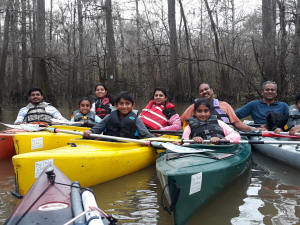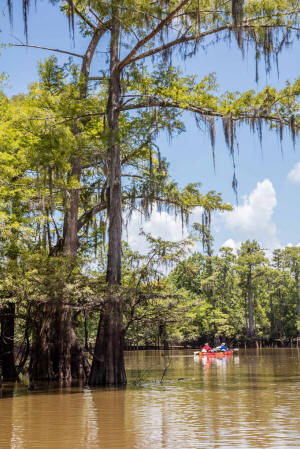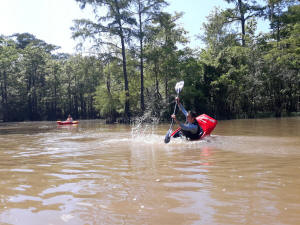Friends, Family
& Fun
With over 3 decades of local experience and knowledge, we
work hard to ensure you, your family and your friends have
everything you need to enjoy the local flora and fauna while
exploring the vast natural waterways and terrain the Big
Thicket has to offer. Whether you wish to participate in a
group outing with other campers, or delve into a more
private setting, we will point you in the right direction.
Family
Oriented and Owned
Our focus on the family experience was taken from our own
experiences with our families. Understanding the importance
of the family unit is critical for us to guarantee you an
adventure with core ethics and values in place. We are a
full service outfitter that understands your needs and
priorities.
Future Goals
As we continue into the future, it is our mission to learn
from our clients by listening to feedback regarding their
experiences. Continuous improvement by providing better
products and services that grows customer satisfaction has
and always will be a top priority here at Big Thicket
Outfitters.
Information on the Big Thicket
The "Big
Thicket"-now
there's a resonant name, one that conjures images of Grimm
Brothers' fairytales and Blair Witches. But in this
83,000-acre swath of East Texas's Piney Woods, truth may
just be stranger than fiction: Dank, dark, and overgrown,
the Big Thicket is a maze of swamps, rivers, and
impenetrably dense forests, a place both weird and
wonderful. There aren't many undiscovered gems left in the
National Parks and Preserves system, but Big Thicket is one
of them. Big Thicket is a naturalist's dream, a remnant of
primeval forest that's been called an "American Ark" for its
biological diversity. The last Ice Age greatly influenced
this region by "herding" species from four different
biological systems into one relatively small area.
Southeastern swamps, eastern forests, central plains, and
southwest deserts all converge here, and odd juxtapositions
are everywhere-magnolias blooming next to cacti, hardwood
forest abutting cypress slough. And as local legend puts it,
"you'll find every critter in there from crickets to
elephants"-the latter may not be true, but there are
armadillos, alligators, panthers and bobcats, snakes, and a
formidable array of insects. Once the inaccessible haunt of
outlaws, well-marked footpaths, boardwalks, and myriad canoe
trails now ply Big Thicket. Next time you're planning to
walk through the looking glass in fall or winter (skip
summer's prostrating heat and legions of bugs), keep Big
Thicket in mind-it offers a fascinating glimpse of how wild
the West can still be.
Hike the Enchanted Forest:
Big Thicket's woods are so dense that during the Civil War
many residents of East Texas fled into the woods to avoid
conscription. Now, the woods are smaller and a little easier
to get into; one of the best hikes is the 15-mile-long
Turkey Creek Trail, which runs from north to south along the
length of the Turkey Creek Unit. It begins in mixed
pine-hardwood forest broken occasionally by sandy knolls,
moves through loblollies and short-leaf pines, rolls along
into an oak, beech, and sweetgum floodplain forest, and
closest to the creek passes through sloughs occupied by huge
bald-cypress trees. Look for the characteristic "knees" of
cypress trees poking out of the swamp; no one has been able
to explain why the trees grow this way. Hikers should keep
in mind that it is very easy to get lost in Big Thicket;
care should be taken to stick to marked trails unless one is
an expert with a compass and a map. But don't let that stop
you from venturing into this curious collection of different
forest types. More on hiking in Big Thicket National
Preserve Paddle the Bayou The best way to explore Big
Thicket's mysteries may be from the water. There are two
designated "Canoe Trails" in the preserve: the Cook's Lake
Canoe Trail and the Franklin Lake Canoe Trail. Located in
the Beaumont Unit of the Preserve, the Cook's Lake Trail is
bounded on the south by Pine Island Bayou and on the east by
the Neches River, where the majestic bald cypress holds
court. The Cook's Lake Canoe Trail follows the bluffs of the
Neches River through the Jack Gore Baygall Unit, which sits
on the western edge of the Preserve. The granddaddy of all
backcountry canoe floats in the Preserve (you won't find any
whitewater here) is the 37-mile length of Village Creek,
whose languorous waters trace nearly the entire length of
Big Thicket. There are no developed water access points
along the creeks in the Preserve, but paddlers can launch at
most road crossings. Get Close-Ups of Carnivorous Plants Big
Thicket National Preserve is home to 85 tree species, more
than 60 shrubs, and nearly 1,000 other flowering plants,
including 26 ferns and allies, 20 orchids, and 4 of North
America's 5 types of insect-eating plants. Most unique of
all, four of the five carnivorous plants indigenous to the
U.S. reside in Big Thicket, including the pitcher plant,
bladderwort, butterwort, and sundew. Aptly named, the Sundew
Trail is where you can see two of these bizarre plants, the
pitcher plant and the sundew. This trail follows the eastern
edge of the Hickory Creek Savannah Unit in the middle of the
preserve's network of 12 units. There are two loops: The
outer loop is 1.6 miles and the inner loop is .8 miles. This
is also a great trail to take in the wildflower bloom from
late spring through summer. Another trail affording looks at
these anomalous plants is the Pitcher Plant Trail, which can
be accessed from a road in the Turkey Creek Unit. Fish Big
Thicket's Waters Big Thicket offers prime bass fishing
territory in addition to a chance to catch white perch and
catfish. Visitors can boat fish on Village Creek, Pine
Island Bayou, and the Neches River, which is home to the
prehistoric paddlefish, a protected species in Big Thicket.
Boat access to the Preserve is limited to these boat ramps:
Dam B (Town Bluff Dam), highway 96 near Evadale, 69 bridge
at Pine Island Bayou, and at the confluence of the Neches
River and Pine Island Bayou. Shore fishing can be had at
Franklin Lake, the pond at the highway beginning of the
Woodland Trail, bridges along the southern edge of the Big
Sandy Unit, and the bridge at the end of Teel House Road in
the Lance Rosier Unit. Wildlife Watching Big Thicket's
diversity is not limited to its flora. There are not many
places in the world where visitors can see a bald eagle and
an alligator in the same day but Big Thicket is one of them.
Those brave enough to venture out at night might catch a
glimpse of a great horned owl swooping in on a flying
squirrel or a mountain lion pouncing on a swamp rabbit. If
snakes are your thing, you'll be happy to know that you can
find milk snakes, copperheads, cottonmouth moccasins, and
timber rattlesnakes all in one place. Nearly 186 kinds of
birds live here or migrate through. Fifty reptile species
include a small, rarely seen population of alligators.
Amphibious frogs and toads abound.
Contact us for more info
|



|